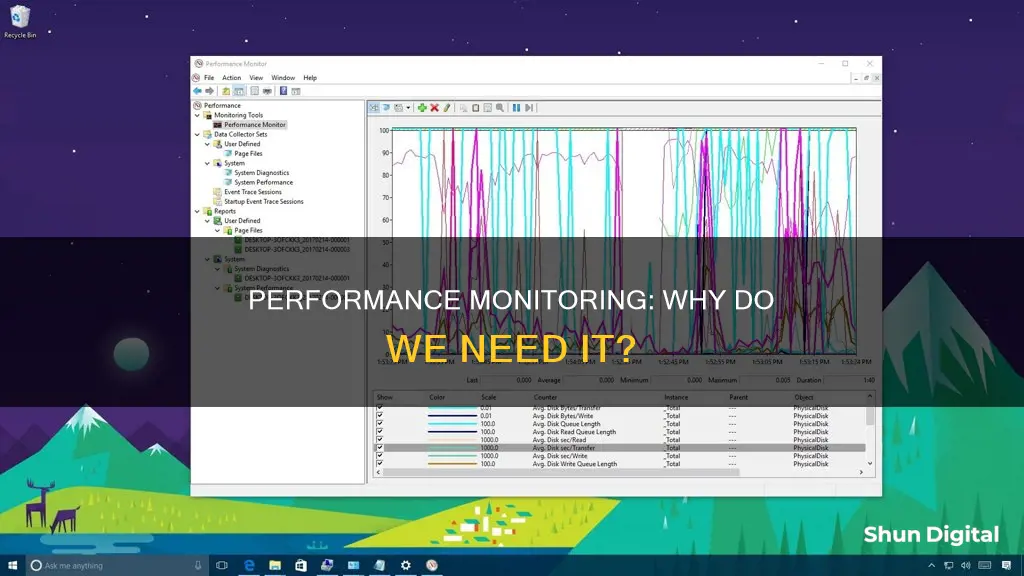
Performance monitoring is a pivotal tool for businesses, helping them to transform raw data into actionable insights. It involves tracking and analyzing the performance of a system and its components, such as CPU usage, memory consumption, and disk activity, to identify deviations from normal behavior and potential issues. This process goes beyond mere data aggregation, employing advanced technologies like analytics platforms, AI, and machine learning to provide robust data analytics that guide strategic decision-making. Performance monitoring is a perpetual cycle of improvement, providing a strategic blueprint for success and helping organizations to optimize their operations, enhance productivity, and achieve sustained growth.
| Characteristics | Values |
|---|---|
| Purpose | To observe and analyze the performance of a system and its components |
| Data sources | CPU or memory usage, hardware, software services, applications, disk activity, network traffic, etc. |
| Data presentation | Graphs, bar charts, lists of numeric values |
| Data collection | Manual or automated |
| Data analysis | Identifying trends, deviations from normal behavior, potential issues |
| Alerts | Can be set up to notify when performance metrics exceed or fall below a threshold |
| Use cases | Troubleshooting, resource allocation, strategic planning, system optimization, decision-making |
| Benefits | Data-driven insights, improved decision-making, increased productivity and efficiency, cost reduction |
| Limitations | Data integrity issues, employee resistance, resource and expertise shortfalls, integration challenges |
What You'll Learn

Performance monitoring tools
There are numerous performance monitoring tools available, each with unique features and capabilities. Here is an overview of some popular performance monitoring tools:
- Dynatrace: This tool offers observability and performance monitoring for both enterprise applications and cloud-native workloads. It includes an AI causation engine and provides intelligent insights at scale.
- Datadog: A SaaS-based observability platform with strong APM capabilities. It offers end-to-end distributed tracing and helps monitor health metrics and service dependencies, reducing latency and errors.
- AppDynamics: A full-stack observability platform that centralises and correlates performance analytics. It provides end-to-end visibility and helps identify the root causes of problems in real time.
- New Relic: A SaaS-based observability platform with APM as a key service. It enables organisations to trace dependencies, detect anomalies, optimise performance, and improve the customer experience.
- ManageEngine Applications Manager: This APM software provides visibility into application performance and user experience, with additional insights through infrastructure monitoring. It supports Java, .NET, PHP, Ruby, and Node.js applications.
- SolarWinds AppOptics: A SaaS-based APM and infrastructure tool for hybrid and cloud-native IT environments. It enables organisations to visualise and troubleshoot application bottlenecks and includes over 150 out-of-the-box plugins and integrations.
- Stackify Retrace: An application performance management and observability platform offered as SaaS. It aggregates performance, log, error, and metric data, providing consolidated monitoring and insights. It includes enhanced search and drill-down capabilities.
- Microsoft System Center Operations Manager (SCOM): An out-of-the-box APM system that offers significant value in application monitoring. It provides deep SQL metrics, extensive IIS and OS monitoring, and intuitive dashboards.
- Performance Monitor: A built-in Windows tool to track and analyse system performance in real time. It monitors CPU usage, memory consumption, disk activity, and network traffic, among other metrics. It offers customisation options and graphical representations for effective performance analysis.
These tools empower users to optimise software, identify bottlenecks, and ensure seamless user experiences.
Monitoring Employee Internet Usage: Privacy at Home?
You may want to see also

Real-time monitoring
In the context of performance monitoring, real-time monitoring allows for the tracking of various system metrics such as CPU usage, memory consumption, disk activity, and network traffic. For example, the Performance Monitor in Windows provides real-time data about memory, network adapter, physical disk, and processor usage.
The benefits of real-time monitoring are significant. It enables organizations to maintain stable and well-maintained operations, enhance security, and efficiently deliver data-driven services. Real-time monitoring is also crucial for proactive system maintenance, as it allows for the early detection of potential issues before they escalate into serious problems. By continuously tracking system metrics, organizations can take prompt interventions, such as adjusting workloads or upgrading hardware, to ensure optimal system performance.
Additionally, real-time monitoring plays a vital role in observability. It offers instant insights into a system's health and performance, allowing organizations to proactively maintain system health, avoid downtime, and optimize the user experience. With real-time monitoring, engineering teams can constantly analyze logs and metrics, optimizing resource allocation, preventing system failures, and improving decision-making.
To implement effective real-time monitoring, several steps are necessary:
- Define specific goals and key metrics to monitor.
- Choose suitable tools that offer flexibility, ease of use, compatibility, and scalability.
- Set up the monitoring system by deploying agents or sensors and establishing secure connections.
- Configure key metrics and alerts to ensure timely and informative notifications.
- Integrate monitoring tools with other systems, such as incident management systems and diagnostics platforms, for seamless data sharing.
- Perform data visualization using dashboards and reporting systems to make data easily understandable.
- Define response procedures and escalation paths to address issues promptly and efficiently.
- Regularly review and optimize the monitoring system to ensure it aligns with changing needs and evolving data.
In conclusion, real-time monitoring is a powerful tool that enables individuals and organizations to stay ahead of the curve by providing instant access to data and insights. By analyzing and responding to information as it occurs, real-time monitoring drives efficient decision-making, optimizes performance, and ensures operational responsiveness.
Ankle Monitors: Effective Surveillance or Easy to Cheat?
You may want to see also

Data-driven insights
Performance monitoring tools enable businesses to transform raw data into actionable insights. This is significant because, despite 58% of companies relying on basic spreadsheets for tracking, only 6% find their review processes genuinely effective. By adopting advanced technologies and AI, businesses can gain a crucial advantage.
Performance monitoring is a perpetual cycle of improvement, providing continuous feedback and real-time enhancements. With 62% of employees feeling blindsided by feedback, there is a need for transparency and a shift in the corporate mindset. It should be an honest and transparent process, mirroring the organisation's values.
Performance monitoring is a strategic process that helps businesses identify improvement and optimisation opportunities. By tracking key performance indicators (KPIs) across diverse areas, companies can make data-driven decisions to maintain their competitive edge and adapt to market shifts.
For instance, in retail, performance monitoring can analyse sales figures, inventory data, and customer satisfaction to suggest modifications such as pricing strategy adjustments, inventory management improvements, or enhanced customer service protocols. Similarly, in manufacturing, performance monitoring can assess production rates, quality checks, and machinery downtime to recommend preventative maintenance or process redesign.
Additionally, performance monitoring plays a vital role in streamlining operations and cutting costs. By carefully analysing performance data, businesses can identify inefficiencies, redundancies, and wasteful practices. They can then
Immersive Viewing: Optimal Size for 1800R Monitors
You may want to see also

Streamlining operations
Performance monitoring involves tracking various metrics and key performance indicators (KPIs) that provide insights into different operational dimensions. These include financial metrics such as revenue and profit margins, operational metrics such as production output and cycle time, employee performance metrics such as sales performance, and customer metrics such as satisfaction levels and retention rates.
By analysing these metrics, businesses can identify bottlenecks and inefficiencies in their operations. For example, performance monitoring can help businesses determine if they need to modify pricing strategies, improve inventory management, or enhance customer service protocols. It also assists in making data-driven decisions about resource allocation, task automation, and cost reduction.
Additionally, performance monitoring enables businesses to establish baselines for "normal" performance, allowing them to quickly identify deviations and address performance issues. This proactive approach ensures that potential problems are addressed before they escalate, reducing downtime and enhancing system reliability.
Furthermore, performance monitoring facilitates continuous improvement and fosters a culture of transparency and accountability within the organisation. By sharing performance insights and results with employees, businesses can encourage open communication, provide recognition for successes, and motivate employees to excel.
Overall, performance monitoring is a powerful tool for streamlining operations, improving efficiency, and driving organisational success. By leveraging data analytics and advanced technologies, businesses can make informed decisions, optimise their processes, and enhance their competitive advantage in the market.
Best Places to Buy Oxygen Saturation Monitors
You may want to see also

Strategic performance monitoring
Formulation, Implementation and Monitoring as Continuous Processes
Financial Indicators and Corporate Social Performance
Financial indicators, such as revenue, profit margins, and return on investment (ROI), provide insights into the economic health of an organisation. Additionally, evaluating corporate social performance is crucial to understanding the broader impact of business activities.
Strategic Alignment of Key Performance Indicators (KPIs)
The selection of KPIs is critical in strategic performance monitoring. These indicators should be directly aligned with the organisation's strategic goals and cover various dimensions, including sales performance, operational efficiency, and customer engagement. This alignment ensures that performance monitoring contributes directly to achieving the desired outcomes.
Robust Data Collection Mechanisms
Accurate and consistent data collection is essential for reliable performance monitoring. Automated systems, standardised processes, and regular quality checks ensure data integrity and enable effective analysis.
Advanced Technologies for Real-Time Monitoring
Leveraging analytics platforms, AI, machine learning, and cloud-based solutions enhances the efficiency and responsiveness of performance monitoring. These technologies enable real-time insights, trend predictions, and dynamic decision-making.
Comprehensive Performance Reviews
Regular performance reviews are vital for assessing progress and refining strategies. They should integrate diverse data sources, involve key stakeholders, and focus on continuous improvement to inform ongoing strategy development.
Enhancing Business Outcomes
Gigabyte Monitors: Better than Acer and Asus?
You may want to see also
Frequently asked questions
Performance monitoring is a powerful tool that helps identify and address performance issues, optimize software development, and improve system efficiency and responsiveness. It provides insights into system health, allowing for proactive system maintenance and early detection of potential issues.
Performance monitoring involves observing and analyzing various system components, such as CPU usage, memory consumption, disk activity, and network traffic. It helps identify deviations from normal behavior and potential issues by establishing baselines for "normal" performance.
Common metrics include CPU usage, memory usage, disk I/O, network bandwidth, and application-specific metrics. These indicators provide a comprehensive view of system health and help identify areas for improvement.







